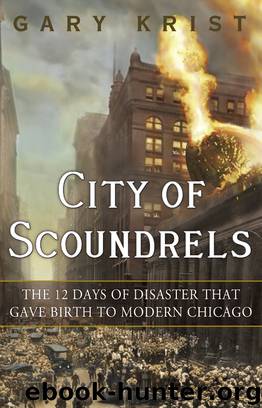City of Scoundrels: The 12 Days of Disaster That Gave Birth to Modern Chicago by Gary Krist

Author:Gary Krist [Krist, Gary]
Language: eng
Format: epub, mobi
Tags: History, Social Science, Sociology, United States, 20th Century, State & Local, Urban, Midwest (IA; IL; IN; KS; MI; MN; MO; ND; NE; OH; SD; WI)
ISBN: 9780307454317
Publisher: Broadway
Published: 2012-04-17T00:00:00+00:00
THE EXODUS STARTED before dawn. With all mass transit except the suburban steam lines idled by the strike, hundreds of thousands of Chicago workers had to get to work on Tuesday morning by whatever means they could find. Desperate for transportation, commuters were hitching rides on laundry vans, bicycles, produce trucks, ice wagons, furniture drays, specially chartered riverboats, and virtually anything else that moved. Long-disused surreys and buggies were brought out of storage; old cab horses were recalled from retirement; flatbed trucks were refitted with kitchen chairs to be reborn as jitneys. Price gouging was rampant. “I stood up in a truck all the way from Garfield Park and paid 15 cents for it,” a female clerk complained to a reporter, “but I’m here.” One boy on the West Side apparently mistook the motley procession of vehicles for a circus parade. “Oh mother, here comes the lion’s cage,” he allegedly cried, pointing to a department store truck carting a load of exasperated women to their jobs.
In the Loop, the traffic jams were epic. With no one to control the flow of vehicles, the result was chaos in the streets. “Never in the history of the city has such a condition prevailed,” one traffic official announced. “Every one of 175 crossing policemen and 75 mounted policemen are detailed to the South Side race riots. Even the Chicago police reserve has been pressed into riot duty. The situation is entirely in the hands of the public. The people must be tolerant.”1
At least half a million other commuters, afraid to venture into the streets, just stayed home. Virtually no one—black or white—showed up for work at the stockyards. Twelve hundred black municipal employees were officially urged to stay off the job. This proved to be a wise move, for the night’s racial violence did not taper off at first light, as it had on Monday. The Evening Post described the mayhem: “Snipers, white as well as black; mobs armed with stones and bricks; arson gangs—all these have been active since daybreak in the face of the police department’s utmost efforts to maintain order.” Some workers who did decide to report to work paid with their lives. Edward W. Jackson, heading on foot to his morning shift at a South Side factory, was beaten to death at Fortieth and Halsted by a group of five white men. Walter Parejko and Josef Maminaki, laborers for the Grand Trunk Railway, were shot by three black youths in front of a Dearborn Street store. Thanks to the beefed-up police presence in the Black Belt, the huge mobs that had proven so unmanageable on Monday night were successfully dispersed on Tuesday, but smaller, more mobile groups were still on the rampage. One report cited a group of twelve armed black soldiers—all former members of the Old Eighth Division—prowling the South Side, shooting at any white faces they saw. The overall outlook was grim. “This is the most serious problem that has ever confronted the police department in Chicago,” Deputy Chief Alcock told his men at the Stanton Avenue station that morning.
Download
City of Scoundrels: The 12 Days of Disaster That Gave Birth to Modern Chicago by Gary Krist.mobi
This site does not store any files on its server. We only index and link to content provided by other sites. Please contact the content providers to delete copyright contents if any and email us, we'll remove relevant links or contents immediately.
| Anthropology | Archaeology |
| Philosophy | Politics & Government |
| Social Sciences | Sociology |
| Women's Studies |
Nudge - Improving Decisions about Health, Wealth, and Happiness by Thaler Sunstein(7255)
iGen by Jean M. Twenge(5166)
The Fire Next Time by James Baldwin(5024)
Adulting by Kelly Williams Brown(4239)
The Hacking of the American Mind by Robert H. Lustig(4092)
The Sports Rules Book by Human Kinetics(4079)
The Ethical Slut by Janet W. Hardy(4042)
Captivate by Vanessa Van Edwards(3732)
Mummy Knew by Lisa James(3522)
In a Sunburned Country by Bill Bryson(3374)
The Worm at the Core by Sheldon Solomon(3327)
Ants Among Elephants by Sujatha Gidla(3282)
Suicide: A Study in Sociology by Emile Durkheim(2908)
The Slow Fix: Solve Problems, Work Smarter, and Live Better In a World Addicted to Speed by Carl Honore(2843)
The 48 laws of power by Robert Greene & Joost Elffers(2816)
Humans of New York by Brandon Stanton(2690)
Handbook of Forensic Sociology and Psychology by Stephen J. Morewitz & Mark L. Goldstein(2605)
The Happy Hooker by Xaviera Hollander(2586)
The Tipping Point by Malcolm Gladwell(2563)
